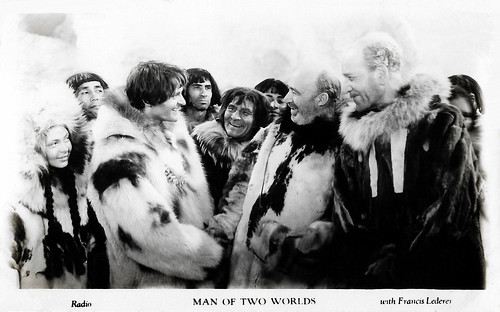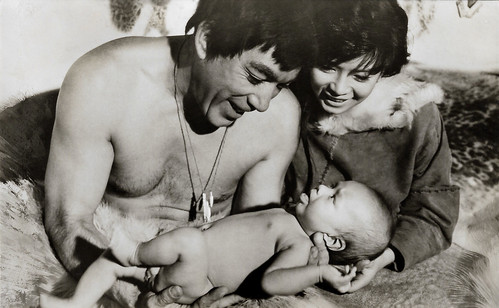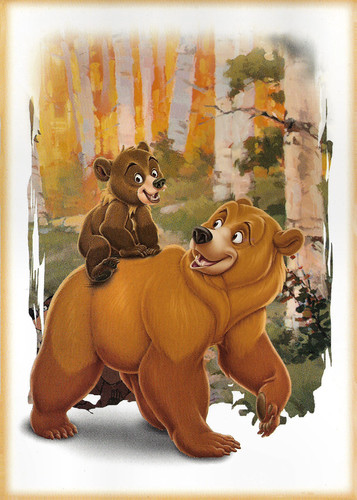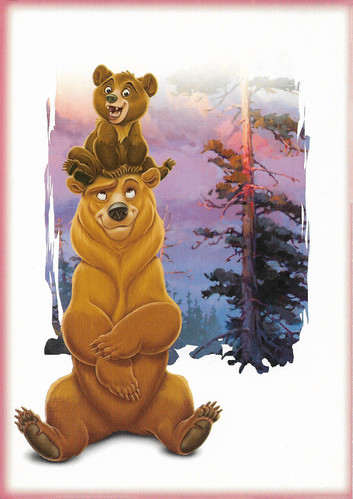Nanook of the North (1922)

German postcard by Dafu Konzern. Publicity for the Berlin screening of the documentary feature Nanook of the North (Robert Flaherty, 1922) with Allakariallak as Nanook. The film was shown at the Berlin cinemas Theater am Nollendorfplatz and the Alhambra at the Kurfürstendamm.
Nanook of the North (Robert J. Flaherty, 1922) was a great success, mainly because it was different from what people were used to. It was the first long film shot on location that really showed the lifestyle of the Inuit instead of a story played by actors. Afterwards, however, it turned out that the film was not entirely realistic. Flaherty had staged some events. For example, at the time of the filming, the Inuit were already using guns for hunting, but Flaherty urged them to go back to hunting as their recent ancestors did. The dangers that the Inuit would face were also exaggerated here and there. For this, Robert J. Flaherty was criticised by some film critics, but in general, they were not too worried about it, as it was common in documentaries at the time for things to be staged. Flaherty further defended his actions by stating that even a documentary maker cannot avoid staging an event once in a while in order to film it properly.
Das Eskimobaby (1918)

German postcard by Photochemie, no. K. 1423. Photo: Neutral-Film. Asta Nielsen and Freddy Wingardh in their outfits from Das Eskimobaby (Walter Schmidthässler, 1918).
In 1915, during a trip to South America, famous Danish film star Asta Nielsen met Freddy Wingårdh, A Swedish fleet lieutenant and son of a shipbuilder. They soon fell in love. Wingårdh made several photos of Nielsen, which were used for postcards issued by the German Photochemie company in Berlin. Wingårdh would also act in Nielsen's film Das Eskimobaby/The Eskimobaby (Walter Schmidthässler or Heinz Schaller, 1918). In this comedy, Asta played the Inuk Ivigtut Sigurdsen and Wingardh appeared as Knud Prätorius. Knud informs his parents by a letter from Greenland that he will be returning home shortly. He will bring a surprise with him from Greenland. The surprise is called Ivigtut Sigurdsen. The female Inuk appears completely uncivilised in the trousers of her people and carelessly pulls the emergency brake on the train because she is not aware of the consequences. In the end, Knud and Ivigtut travel back to Greenland with their child, and Knud's parents have in the meantime become comfortable with the idea of an Inuit daughter-in-law. Contemporary critics praised Das Eskimobaby and Nielsen's performance.

German postcard by Photochemie, Berlin, no. K. 1422. Photo: Neutral-Film. Asta Nielsen in Das Eskimobaby (Walter Schmidthaessler, 1916).
Man of Two Worlds (1934)

British postcard in the Film Shots series by Film Weekly. Photo: Radio (RKO). Francis Lederer in Man of Two Worlds (J. Walter Ruben, 1934).
With the success of Flaherty's Nanook of the North (1922), Hollywood tried to replicate the box office by using Inuit themes. In Man of Two Worlds (J. Walter Ruben, 1934), British explorer Sir Basil (Henry Stephenson) in the Arctic hires a local Inuk as an assistant. The earnest but unsophisticated young man called Aigo (Francis Lederer) happens to see a photograph of the explorer's beautiful daughter and falls in love with her. Soon afterwards a medical emergency results in his being flown to London for treatment, where he finally meets the girl he has longed for. Once in Britain, Aigo is treated as a curiosity - like some sort of simple-minded thing instead of a person. He likes what he sees - particularly Sir Basil's daughter. In his mind, he's envisioned that she is destined to be his - and, of course, he's setting himself up for disappointment. No one seems to believe, including the girl, that Aigo has normal human desires and urges. The film was a box office disappointment for RKO.

British postcard in the Film Shots series by Film Weekly. Photo: Radio (RKO). Steffi Duna and Francis Lederer in Man of Two Worlds (J. Walter Ruben, 1934).

British postcard in the Film Shots series by Film Weekly. Photo: Radio (RKO). Steffi Duna and Francis Lederer in Man of Two Worlds (J. Walter Ruben, 1934).
The Savage Innocents (1959)

West-German card. Photo: Rank Film. Anthony Quinn and Yoko Tani in The Savage Innocents (Nicholas Ray, 1959).
Mexican-American actor Anthony Quinn and French-born Japanese actress Yoko Tani starred as an Inuit couple in the adventure film The Savage Innocents (1960), directed and co-written by Nicholas Ray. The film's themes include Inuit survival in the extreme arctic wilderness, as well as their raw existence and struggle to maintain their lifestyle against encroaching civilization. The Savage Innocents was adapted from the novel 'Top of the World' by Swiss writer Hans Rüesch. Quinn plays an Inuk hunter Inuk who kills a Christian missionary who rejects his traditional offer of food and his wife's company. Pursued by white policemen, the Inuk saves the life of one of them, resulting in a final confrontation in which the surviving cop must decide between his commitment to law enforcement and his gratitude to the Inuk. The film was an international co-production, with British, Italian and French interests involved. The Savage Innocents was shot on-location in the Canadian Arctic, with interiors shot in Britain's Pinewood Studios and in Rome's Cinecittà studios. It was entered at the 1960 Cannes Film Festival.
Brother Bear (2003)

French postcard by Jump, Paris, for McDonald's. Image: Walt Disney Pictures. Publicity still for Brother Bear (Aaron Blaise, Robert Walker, 2003).
Brother Bear (Aaron Blaise, Robert Walker, 2003) is an American animated musical fantasy comedy-drama produced by Walt Disney Studios. In a post-ice age Alaska, the local tribes believe all creatures are created through the Great Spirits, who are said to appear in the form of an aurora. Native boy Kenai pursues a bear and kills it, but the Spirits, incensed by this unnecessary death, change Kenai into a bear himself as punishment. In order to be human again, Kenai must travel to a mountain where the Northern lights touch the earth. In the Chicago Sun-Times, Roger Ebert wrote the film "doesn't have the zowie factor of The Lion King or Finding Nemo, but is sweet rather than exciting. Children and their parents are likely to relate on completely different levels, the adults connecting with the transfer of souls from man to beast, while the kids are excited by the adventure stuff." The film received a nomination for Best Animated Feature at the 76th Academy Awards, losing to Pixar's Finding Nemo. The film grossed $250 million against a $46 million budget.

French postcard by Cartoon Collection, réf. 28963. Image: Walt Disney Pictures. Publicity still for Brother Bear (Aaron Blaise, Robert Walker, 2003). The French title is Frère des ours.

French postcard by Cartoon Collection, réf. 28964. Image: Walt Disney Pictures. Publicity still for Brother Bear (Aaron Blaise, Robert Walker, 2003). The French title is Frère des ours.
Sources: Wikipedia (German and English), and IMDb.
This post only shows a small selection of films on the Inuit, films of which we had postcards in our collection. Wikipedia offers a bigger selection.
No comments:
Post a Comment